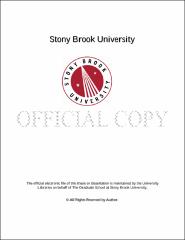| dc.identifier.uri | http://hdl.handle.net/11401/76702 | |
| dc.description.sponsorship | This work is sponsored by the Stony Brook University Graduate School in compliance with the requirements for completion of degree. | en_US |
| dc.format | Monograph | |
| dc.format.medium | Electronic Resource | en_US |
| dc.language.iso | en_US | |
| dc.publisher | The Graduate School, Stony Brook University: Stony Brook, NY. | |
| dc.type | Dissertation | |
| dcterms.abstract | Explanation of the quantization of the Hall conductance at low temperatures in strong magnetic field is one of the greatest accomplishments of theoretical physics of the end of the 20th century. Since the publication of the Laughlin's charge pumping argument condensed matter theorists have come a long way to topological insulators, classification of noninteracting (and sometimes interacting) topological phases of matter, non-abelian statistics, Majorana zero modes in topological superconductors and topological quantum computation - the framework for ``error-free'' quantum computation. While topology was very important in these developments, geometry has largely been neglected. We explore the role of space-time symmetries in topological phases of matter. Such symmetries are responsible for the conservation of energy, momentum and angular momentum. We will show that if these symmetries are maintained (at least on average) then in addition to Hall conductance there are other, in principle, measurable transport coefficients that are quantized and sensitive to topological phase transition. Among these coefficients are non- dissipative viscosity of quantum fluids, known as Hall viscosity; thermal Hall conductance, and a recently discovered coefficient - orbital spin variance. All of these coefficients can be computed as linear responses to variations of geometry of a physical sample. We will show how to compute these coefficients for a variety of abelian and non-abelian quantum Hall states using various analytical tools: from RPA-type perturbation theory to non-abelian Chern-Simons-Witten effective topological quantum field theory. We will explain how non-Riemannian geometry known as Newton-Cartan (NC) geometry arises in the computation of momentum and energy transport in non-relativistic gapped systems. We use this geometry to derive a number of thermodynamic relations and stress the non-relativistic nature of condensed matter systems. NC geometry is also useful in the study of Galilean invariant systems in manifestly coordinate independent form. We study the Ward identities of the Galilean symmetry and find new relations between universal, quantized transport coefficients and long-wave corrections there of. | |
| dcterms.available | 2017-09-20T16:51:01Z | |
| dcterms.contributor | Abanov, Alexander G. | en_US |
| dcterms.contributor | Weinacht, Thomas | en_US |
| dcterms.contributor | Kirillov, Alexander. | en_US |
| dcterms.contributor | Herzog, Christopher | en_US |
| dcterms.creator | Gromov, Andrey | |
| dcterms.dateAccepted | 2017-09-20T16:51:01Z | |
| dcterms.dateSubmitted | 2017-09-20T16:51:01Z | |
| dcterms.description | Department of Physics. | en_US |
| dcterms.extent | 193 pg. | en_US |
| dcterms.format | Monograph | |
| dcterms.format | Application/PDF | en_US |
| dcterms.identifier | http://hdl.handle.net/11401/76702 | |
| dcterms.issued | 2015-12-01 | |
| dcterms.language | en_US | |
| dcterms.provenance | Made available in DSpace on 2017-09-20T16:51:01Z (GMT). No. of bitstreams: 1
Gromov_grad.sunysb_0771E_12417.pdf: 1543219 bytes, checksum: 2dd03fb14d203246123181d6eb75c0d9 (MD5)
Previous issue date: 1 | en |
| dcterms.publisher | The Graduate School, Stony Brook University: Stony Brook, NY. | |
| dcterms.subject | bulk-boundary correspondence, Framing anomaly, Hall viscosity, quantum Hall effect, thermal Hall effect, topological phases of matter | |
| dcterms.subject | Condensed matter physics | |
| dcterms.title | Geometric Aspects of Quantum Hall States | |
| dcterms.type | Dissertation | |

